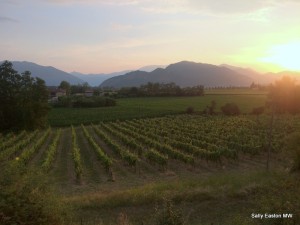Franciacorta – the blink of an eye in 40 years?
The year 1961 was an illustrious vintage in that most traditional of wine regions, Bordeaux. But it was also a seminal year for Italy’s Franciacorta –the year a handful of producers started making traditional method sparkling wine, from just 29 hectares of vines. This marked a notable change for a region with a winemaking history stretching to the 16th century, plus a longer heritage evidenced by Roman artefacts (sometimes there’s not so much new in winemaking).
It took another generation before this product would be called, simply, Franciacorta. Now that word alone on a label, without recourse to explanation of DOCG, or traditional method, or vino spumante, is synonymous with all those things.
And from these modest beginnings Franciacorta has become known as Italy’s foremost traditional method sparkling wine region:
In 1967 Franciacorta became a DOC
In 1990 the consorzio was formed to oversee and protect production protocols
In 1995 Franciacorta became a DOCG, and, with it the familiarity of a ‘first name only’ basis of nomenclature. Like Cher, or Madonna, maybe!
In 1997 the first DOCG bottles, i.e. the modern guise of Franciacorta were sold … less than 20 years ago.
Franciacorta is located in the Brescia province of Lombardy, immediately on the southern shores of Lake d’Iseo, on undulating, old glacial moraine hills. Glacial ice was blocked from further southerly migration by Monte Orfano, a 452m ASL free-standing (orphan) hill. It is bordered to the east by the mountains of Brusati, Ome and Gussago; to the west Monte Alto looks over it all from its peak position of 651m ASL.
Most of the vineyards are on these glacial moraines at 200-250m ASL, with some going higher. Ca’del Bosco own the highest vineyard in Franciacorta at 460m ASL, planted with pinot noir on a north-facing aspect.
Comparisons with Champagne are inevitable, even if sometimes useful. Let’s deal with them, without recourse to flavour profile in the glass, which is rather different. Giuseppe Salvioni, CEO of the consorzio Franciacorta said there is “absolutely not a face-to-face competition with champagne. There is some similar ground. … [but, for example] we are not interested to have such a high level of acidity.”
| Franciacorta | Champagne | |
| Area under vine | 2,800 hectares | 33,700 hectares |
| Producers | ~ 100 | ~ 15,800 |
| Vineyard altitude | 200 to 250m Some up to 450m ASL |
90 to 300m |
| Broad climate | Pre-Alpine continental with moderating influence of Lake d’Iseo | Continental with moderating influence of Atlantic ocean |
| Total bottle sales in 2014 | 15.5 million | 308 million |
| Of which, exports… | 1.4 million (9%) | 144.9 million (47%) |
| Max yield | ~ 9.5 tonnes/ ha | ~13 tonnes/ha (in 2014) |
| Grape variety planting split | 82% chardonnay 14% pinot noir 4% pinot bianco |
38% pinot noir 32% pinot meunier 30% chardonnay |
| Blending/assemblage rules | Pinot bianco (max 50%), chardonnay, pinot noir, | Blanc de Blanc from chardonnay Blanc de Noirs from pinot noir, pinot meunier |
| Min. time on lees NV | 18 months (25 months’ total vinification / maturation) | 12 months (15 months’ total maturation) |
| Min. time on lees Rosé | 24 months | 12 months |
| Min. time on lees Vintage | 30 months (37 months’ total vinification / maturation) | 36 months |
| Min. time on lees Saten | 24 months | n/a |
| Min. time on lees Riserva | 60 months | n/a |
| Dosage/RS levels | As per EU legislation | As per EU legislation |
| Length of history of bubbly production | ~ 50 years | ~ 300 years |
| Malolactic fermentation | No generalisations | No generalisations |
| Biggest producers | Berlucchi 4.4m bottles Bellavista 1.2m Ca’del Bosco 1.1m bottles |
Moet & Chandon >30m (Avellan/Stevenson, 2013) |
Even in the region’s brief sparkling history, pinot bianco used to account for more plantings, which explains the maximum 50% rule. It is used, Salvioni said, “to improve the aromatic complexity”, but this only works up to a point.
Franciacorta looks set to remain niche. Salvioni said Franciacorta may only ever reach around 26 to 28m bottles’ production, if all the estimated 300-400ha possible to be planted, are planted. To complete the Champagne comparison, its production was 337m bottles in 2014.
My visit was sponsored by the Franciacorta consortium.




